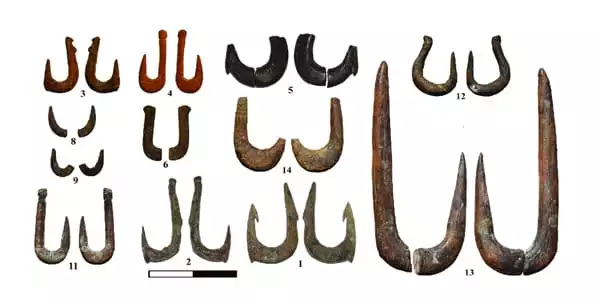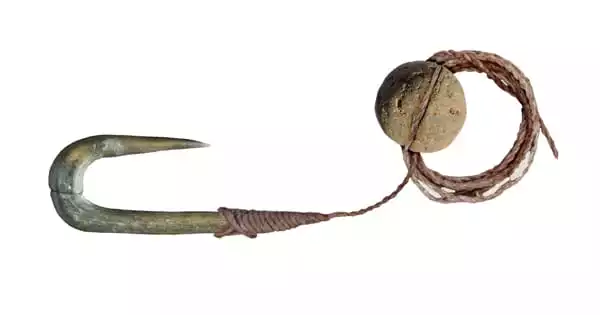Nineteen broken and complete bone fish hooks and six grooved stones recovered from the Epipaleolithic site of Jordan River Dureijat in Israel’s Hula Valley represent the most extensive collection of Epipaleolithic and Paleolithic fishing technology.
Nearly two million years ago, fish remains first appeared in hominin sites. Although fish skeletal remains and isotope data provide reasonable proxies for fish’s role in hominin diets, the technology used to capture them in prehistory is more elusive. This is primarily due to the fact that the vast majority of fishing gear was made from perishable materials like wood and plant fibers, which rarely survive in archaeological contexts.
According to a study published in the open-access journal PLOS ONE by Antonella Pedergnana of the Archaeological Research Centre and Museum for Human Behavioural Evolution in Mainz, Germany, and colleagues, humans in the Middle East were using complex fishing tools and techniques by 12,000 years ago.
Fish have long been an important part of human diets, but studying the history of the technology humans have used to acquire fish is difficult, in part because early fishing gear was made from perishable materials such as wood and plant fibers. Pedergnana and colleagues examined a collection of fishing hooks and stones from the Jordan River Dureijat archaeological site in northern Israel, which dates back at least 12,000 years.
Modern fishing, with the exception of the use of metal and plastic, has not invented anything new since the Natufian. A look at the JRD fishing equipment reveals that all fishing techniques and knowledge existed 13,000 years ago. The discoveries emphasize the significance of aquatic resources in the emergence of sedentism and Neolithic lifeways in the Levant.
As a result of a drainage operation, the waterlogged Jordan River Dureijat site was discovered in 1999. According to an earlier study published in the PaleoAnthropology journal, it was a short-term encampment that was intermittently occupied over a 10,000-year period during the Levantine Epipaleolithic periods. It was never inhabited, but rather a place where people came to fish, hunt, and take advantage of other natural resources on a regular basis.
The researchers examined the shape and residues of 19 bone fish hooks, as well as six grooved pebbles that appear to have been used as sinkers, for one of the most extensive collections of early fishing technology ever assembled. The presence of plant fiber residue on the hooks and stones indicates the use of fishing line, and the wide range of hook shapes, including multiple arrangements of barbs and multiple methods for attaching hook to line, reflects their utility for catching a variety of fish. Grooved lines and fiber residues on the bends of some hooks also indicate the use of artificial lures.
This research uncovers some of the earliest signs of complex fishing technology. The use of lures and a wide range of hook shapes suggests that humans at this time were not only hunting a diverse range of fish, but also had a thorough understanding of fish behavior and ecology. These innovations correspond to broader patterns in human subsistence evolution, heralding the start of the transition to agriculture in this part of the world.

The authors continue: “Modern fishing, with the exception of the use of metal and plastic, has not invented anything new since the Natufian. A look at the JRD fishing equipment reveals that all fishing techniques and knowledge existed 13,000 years ago. The discoveries emphasize the significance of aquatic resources in the emergence of sedentism and Neolithic lifeways in the Levant.”
The study of fish hooks reveals significant variability in hook size, shape, and feature type, as well as the first evidence that several landmark innovations in fishing technology were already in use at this early date. Inner and outer barbs, a variety of line attachment techniques such as knobs, grooves, and adhesives, and some of the earliest evidence for artificial lures are among these. Plant fibers recovered from the grooves of one hook shank and one stone suggest the use of a fishing line, whereas wear on the grooved stones is consistent with their use as sinkers.
This, combined with the presence of grooved stones and hooks in the same archaeological layers, suggests the emergence of a sophisticated line and hook technology. The multiple steps required to manufacture each component and combine them into an integrated system highlight the technology’s complexity. The presence of such technology in the Levantine Epipaleolithic record demonstrates a thorough understanding of fish behavior and ecology. This corresponds with significant larger-scale patterns in subsistence evolution, namely broad-spectrum foraging, which is an important first signal of the start of the agricultural transition in this region.
Archaeologists also discovered remnants of an adhesive used to secure the line. The presence of deep grooves, adhesives, and animal hair on the ends of two hooks confirmed the use of artificial bait. These lures could have contained “shell flutters,” or pieces of gleaming mother-of-pearl that spin in the water and attract fish. Shiny lures are still used by modern anglers, and lightweight lures are used with specific casting techniques, such as fly fishing.





